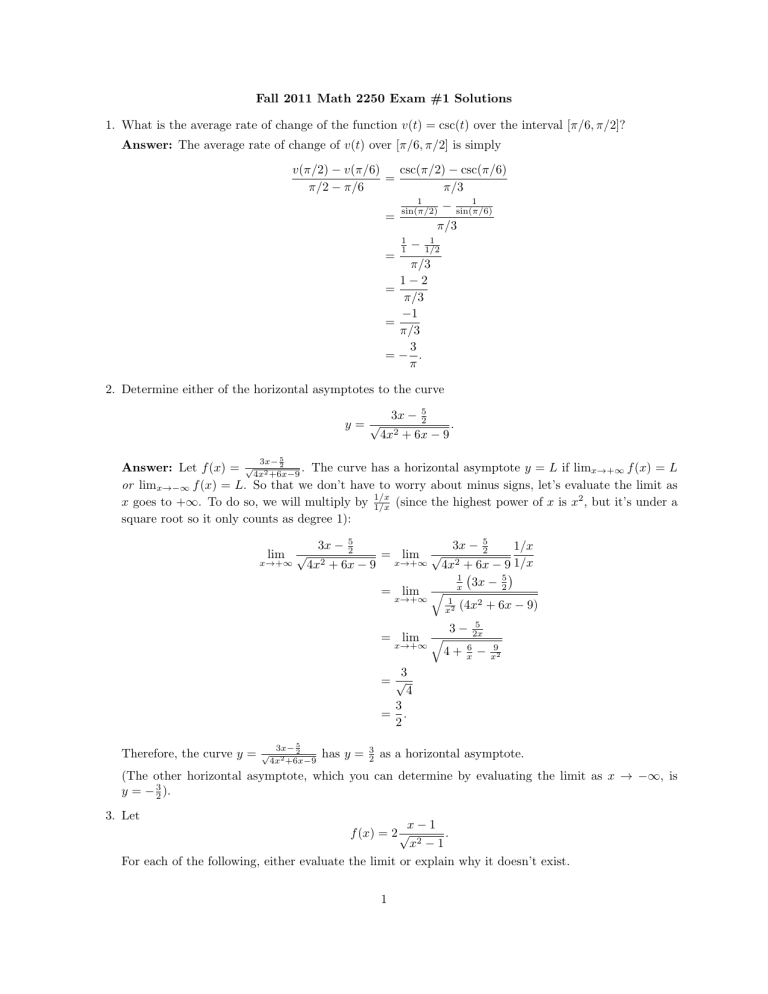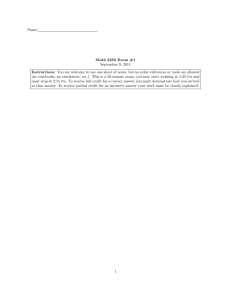Fall 2011 Math 2250 Exam #1 Solutions
advertisement

Fall 2011 Math 2250 Exam #1 Solutions 1. What is the average rate of change of the function v(t) = csc(t) over the interval [π/6, π/2]? Answer: The average rate of change of v(t) over [π/6, π/2] is simply v(π/2) − v(π/6) csc(π/2) − csc(π/6) = π/2 − π/6 π/3 1 1 − sin(π/2) sin(π/6) = π/3 1 1 1 − 1/2 = π/3 1−2 = π/3 −1 = π/3 3 =− . π 2. Determine either of the horizontal asymptotes to the curve y=√ 3x − 5 2 4x2 + 6x − 9 . 3x− 5 2 Answer: Let f (x) = √4x2 +6x−9 . The curve has a horizontal asymptote y = L if limx→+∞ f (x) = L or limx→−∞ f (x) = L. So that we don’t have to worry about minus signs, let’s evaluate the limit as 2 x goes to +∞. To do so, we will multiply by 1/x 1/x (since the highest power of x is x , but it’s under a square root so it only counts as degree 1): lim √ x→+∞ 3x − 4x2 5 2 + 6x − 9 = lim √ x→+∞ 3x − 1/x + 6x − 9 1/x 1 5 x 3x − 2 4x2 = lim q x→+∞ = lim q x→+∞ 5 2 1 x2 (4x2 + 6x − 9) 3− 4+ 6 x 5 2x − 9 x2 3 =√ 4 3 = . 2 Therefore, the curve y = 3x− 52 √ 4x2 +6x−9 has y = 3 2 as a horizontal asymptote. (The other horizontal asymptote, which you can determine by evaluating the limit as x → −∞, is y = − 32 ). 3. Let x−1 f (x) = 2 √ . x2 − 1 For each of the following, either evaluate the limit or explain why it doesn’t exist. 1 (a) lim f (x) x→1+ Answer: Notice, first of all, that both the numerator and the denominator are going to zero, so we need to get a bit clever. Since x2 − 1 = (x − 1)(x + 1), we can write p p √ √ x2 − 1 = (x − 1)(x + 1) = x − 1 x + 1. Therefore, √ x−1 x−1 x−1 √ = lim+ 2 √ = lim+ 2 √ = 0, lim+ 2 √ 2 x→1 x − 1 x + 1 x→1 x+1 x − 1 x→1 √ since the numerator is going to zero while the denominator goes to 2. (b) lim f (x) x→1− √ Answer: Notice that x2 − 1 is undefined for all x between −1 and 1, so f (x) is undefined on this whole interval. Therefore, f (x) is undefined for x approaching 1 from the left, so the limit is also undefined. (c) lim f (x) x→−1− Answer: We have that x−1 lim 2 √ = −∞ x2 − 1 x→−1− since the numerator of the fraction is going to −2 (and in particular is negative for all x to the left of −1) and the denominator is going to 0 and is always positive. √ 4. Find the equation of the tangent line to the curve y = x at the point (4, 2). √ Answer: We know that the slope of a secant line through (4, 2) and some nearby point (4 + h, 4 + h) is given by √ √ 4+h− 4 . h Letting h go to zero will yield the slope of the tangent line. More formally, the slope of the tangent line is √ √ √ √ √ √ 4+h− 4 4+h− 4 4+h+ 4 √ lim = lim ·√ h→0 h→0 h h 4+h+ 4 (4 + h) − 4 √ = lim √ h→0 h( 4 + h + 4) h = lim √ h→0 h( 4 + h + 2) 1 = lim √ h→0 4+h+2 1 = . 4 The key step here (in the first line) is to rationalize the numerator. 2 Now, we can use the point-slope formula to determine the equation of the tangent line: 1 (x − 4) 4 x y−2= −1 4 x y = + 1. 4 y−2= 5. Define g(2) in a way that extends the function g(x) = sin x2 − 4x + 4 x−2 to be continuous at x = 2. Answer: As given, g is not defined at x = 2. However, h(x) = sin(x) is continuous everywhere and 2 k(x) = x −4x+4 is a quotient of polynomials and, hence, continuous everywhere it’s defined, meaning x−2 everywhere except x = 2. Therefore, the limit laws imply that g(x) = (h ◦ k)(x) is already continuous everywhere except x = 2. Since g being continuous at x = 2 would mean that lim g(x) = g(2), x→2 we just need to define g(2) to be limx→2 g(x) in order to get g to be continuous at x = 2. Therefore, the problem boils down to computing this limit. 2 (x − 2)2 x − 4x + 4 = lim sin lim sin x→2 x→2 x−2 x−2 = lim sin(x − 2) x→2 = sin(2 − 2) =0 where we can pass from the 2nd to the 3rd lines since sin(x − 2) is continuous everywhere, including at x = 2. Hence, we can extend g to a function which is continuous at x = 2 by defining g(2) = 0. 3




